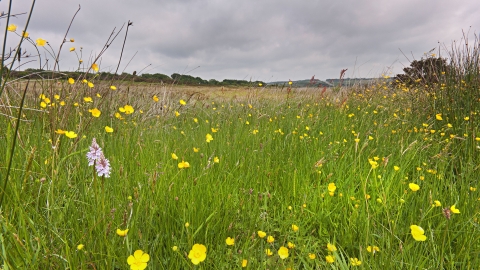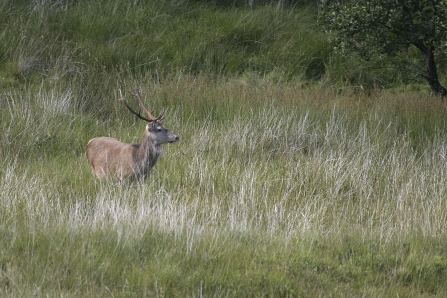
Knowstone. Photo, Dave Chamberlain
Rackenford and Knowstone Moors
Know before you go
Dogs
When to visit
Opening times
Open at all timesBest time to visit
May to SeptemberAbout the reserve
A sense of space and timelessness greets the visitor stepping out on to the largest surviving area of culm grassland in Devon.
Ash dieback
The disease ash dieback is now widespread in the UK and is present at many of our nature reserves, so we carry out tree felling across our sites in winter months. For your own safety please observe temporary path diversions and closures.
Where possible we will leave affected ash trees in place to decay naturally as an important habitat for wildlife. We plan to only fell diseased ash trees which pose a threat to people or infrastructure. Before trees are felled, we will check whether any rare or protected wildlife is present. If it is, we will postpone or avoid felling these trees. No felling will take place during the bird nesting season.
DWT’s Saving Devon’s Treescapes project are working with communities, landowners and businesses to help make Devon's precious treescapes more resilient in the face of ash dieback. Find out how you can get involved here.
NOTICE: If you are visiting our reserves, please note that there have been instances of H5N1 Avian bird flu found in birds in Devon. There is very low risk to public health, but we do ask that if you come across any unusual or unexplained bird deaths on or near our reserves, please do not touch them and avoid allowing your dog to come into contact with dead birds. Please report them to Defra here or call 03459 335577 and also report your findings to DWT by email at contactus@devonwildlifetrust.org.
Contact us
Environmental designation
Location map
How to get to Rackenford and Knowstone Moors
Size matters
Culm grassland is a rare habitat comprising distinctive wetland plants, sustained by acidic clay soils, light grazing, and high rainfall. This combination of environmental conditions with low intensity land management, largely unchanged since prehistoric times, maintains the site's wildlife richness.
Unbroken views, as far as the edges of Dartmoor and Exmoor, reach across a diverse array of wet pastures, heaths, bogs and mires, scrub and fringes of woodland. This may lend an impression of vast ancient emptiness, but in the last century over 90% of culm grassland has been lost.
Much of what remains is to be found fragmented across north Devon. Rackenford and Knowstone moor is of crucial value as the most extensive remnant still in existence today. Devon Wildlife Trust works to protect, re-create and link together isolated culm grassland sites through the Working Wetlands and North Devon Nature Improvement Area projects.
Crossing swards
As well as the eye, this is a place to be experienced with the feet. Visitors may freely roam the bumpy purple moor grass tussocks and boggy patches of rush, alongside the cattle and deer, though the reserve's special features are most easily accessed from the surfaced paths.
A slower pace is also a good way to appreciate the site's key wildlife interest, lower down in the sward beneath eye level. A variety of different plant communities await discovery, from purple moor-grass dominated mires, rush pastures and wet heaths, to tall herb fens.
In drier areas look out for the purple of saw wort, meadow thistle, and heathers. Wetter areas are home to sharp-flowered rush, ragged robin, marsh bedstraw, meadowsweet and wild angelica. Waterlogged soils give rise to bog vegetation, with Sphagnum mosses, sundews, bog pondweed and sedges. The non-intensively managed nature of the land allows a number of uncommon plants to thrive, with a high diversity of species per square metre, growing together in associations which are nationally rare.
Devil in the detail
The range of flowers supports several scarce butterflies, moths and other insects, including small pearl-bordered fritillary, wood white, marbled white, dingy skipper, small heath, double line moth and keeled skimmer dragonfly.
One characterstic plant is especially important: Devil's-bit scabious, food plant of the marsh fritillary butterfly (one of the most threatened species in Europe), nationally rare narrow-bordered bee hawk-moth, and the scabious jewel beetle. Late nectar provided by the blue pin cushion scabious flowers attracts high numbers of insect species in autumn.
Foraging or roosting among the tussocks might be barn owl, curlew, snipe, woodcock, willow tit, reed bunting and grasshopper warbler, while reptiles and amphibians such as common frog, toad, viviparous lizard and grass snake are hidden below.

Red deer. Photo, Darin Smith
Seeing red
Mammals to look out for include harvest mice, fox, roe deer, and otter, or at least the field signs they leave behind. In contrast, red deer, the UK's largest wild land animal, should be more easily visible. Visit the reserve around October to witness the rut, when these big beasts contest the opportunity to reign over this big landscape.
Site improvements
We're very grateful for a Landfill Communities Fund grant of £40,231 from Valencia Communities Fund, which enabled a variety of habitat improvements to take place throughout autumn/winter 2023-24:
- Removed areas of scrub and 2.5km of old livestock fencing
- Installed three-strand barbed wire fence on chestnut posts
- Installed five field gates, a kissing gate and livestock handling pen
- All this will enable safer and more targeted grazing by livestock to keep the culm habitat in great condition for fritillaries and other special species
Our staff and volunteers complimented the work above by cutting back willow encroaching on open habitat, and a programme of coppicing to enhance adjacent wet woodland.
This project was also enabled by a donation from The Dixon Foundation.

